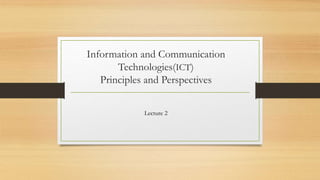Conceptual Model
•Als PPTX, PDF herunterladen•
0 gefällt mir•72 views
Information and communication technologies principles and perspectives
Melden
Teilen
Melden
Teilen

Empfohlen
Empfohlen
Weitere ähnliche Inhalte
Was ist angesagt?
Was ist angesagt? (20)
Ähnlich wie Conceptual Model
Ähnlich wie Conceptual Model (20)
Interaction design: desiging user interfaces for digital products

Interaction design: desiging user interfaces for digital products
Human Computer Interaction: Lecture 2: Interaction Design

Human Computer Interaction: Lecture 2: Interaction Design
Mehr von Saqib Shehzad
Mehr von Saqib Shehzad (20)
Cognition, information processing, perception and attention

Cognition, information processing, perception and attention
Kürzlich hochgeladen
God is a creative God Gen 1:1. All that He created was “good”, could also be translated “beautiful”. God created man in His own image Gen 1:27. Maths helps us discover the beauty that God has created in His world and, in turn, create beautiful designs to serve and enrich the lives of others.
Explore beautiful and ugly buildings. Mathematics helps us create beautiful d...

Explore beautiful and ugly buildings. Mathematics helps us create beautiful d...christianmathematics
Mehran University Newsletter is a Quarterly Publication from Public Relations OfficeMehran University Newsletter Vol-X, Issue-I, 2024

Mehran University Newsletter Vol-X, Issue-I, 2024Mehran University of Engineering & Technology, Jamshoro
https://app.box.com/s/7hlvjxjalkrik7fb082xx3jk7xd7liz3TỔNG ÔN TẬP THI VÀO LỚP 10 MÔN TIẾNG ANH NĂM HỌC 2023 - 2024 CÓ ĐÁP ÁN (NGỮ Â...

TỔNG ÔN TẬP THI VÀO LỚP 10 MÔN TIẾNG ANH NĂM HỌC 2023 - 2024 CÓ ĐÁP ÁN (NGỮ Â...Nguyen Thanh Tu Collection
Kürzlich hochgeladen (20)
Asian American Pacific Islander Month DDSD 2024.pptx

Asian American Pacific Islander Month DDSD 2024.pptx
ICT Role in 21st Century Education & its Challenges.pptx

ICT Role in 21st Century Education & its Challenges.pptx
Micro-Scholarship, What it is, How can it help me.pdf

Micro-Scholarship, What it is, How can it help me.pdf
Explore beautiful and ugly buildings. Mathematics helps us create beautiful d...

Explore beautiful and ugly buildings. Mathematics helps us create beautiful d...
TỔNG ÔN TẬP THI VÀO LỚP 10 MÔN TIẾNG ANH NĂM HỌC 2023 - 2024 CÓ ĐÁP ÁN (NGỮ Â...

TỔNG ÔN TẬP THI VÀO LỚP 10 MÔN TIẾNG ANH NĂM HỌC 2023 - 2024 CÓ ĐÁP ÁN (NGỮ Â...
Food safety_Challenges food safety laboratories_.pdf

Food safety_Challenges food safety laboratories_.pdf
Conceptual Model
- 1. Information and Communication Technologies(ICT) Principles and Perspectives Lecture 2
- 2. Design Principles • Visibility • Feedback • Constraint • Consistency • Affordance Tradeoff
- 3. Problem space • Definition • Orientation • Open mindedness • Common Ground
- 4. Conceptual Model • A high-level description of how a system is organized and operates. What people can do with a product and what concepts are required to understand how to interact with it? • Goals • Keep it simple as much as possible • Few or No concept from outside of task domain
- 5. Core Components of Conceptual Model • Metaphors and analogies • Concepts exposed through product • Relationships between these concepts • Mapping between these concepts
- 6. Interface Metaphor • An Interface metaphor is a set of user interface visuals, actions and procedures that exploit specific knowledge that users already have of other domains. • Examples • Folders • Bin (Recycle Bin) • Shopping cart
- 7. Benefits of Interface metaphor • Makes learning new systems easier • Helps users understand the underlying conceptual model • Can be very innovative and enable the realm of computers and their applications to be made more accessible to a greater diversity of users
- 8. Interaction Types • Instructing • Conversing • Manipulating • Exploring (time and place theory)
- 9. Instructing • Where users instruct a system and tell it what to do • –e.g. tell the time, print a file, save a file • Very common conceptual model, underlying a diversity of devices and systems • e.g. word processors, VCRs, vending machines • Main benefit is that instructing supports quick and efficient interaction • good for repetitive kinds of actions performed on multiple objects
- 11. Conversing • Underlying model of having a conversation with another human • Range from simple voice recognition menu-driven systems to more complex ‘natural language’ dialogs • Examples include ticket booking, flight time inquiry, search engines, advice- giving systems, help systems • Also virtual agents, toys and pet robots designed to converse with you
- 12. Conversing
- 13. Pros and Cons of Conversation Model • Allows users, especially novices and technophobes, to interact with the system in a way that is familiar • Makes them feel comfortable, at ease and less scared • Misunderstandings can arise when the system does not know how to parse what the user says
- 14. Manipulating • Involves dragging, selecting, opening, closing and zooming actions on virtual objects • Exploit’s users’ knowledge of how they move and manipulate in the physical world • Direct Manipulation • Continuous representation of objects and actions of interest • Physical actions and button pressing instead of issuing commands with complex syntax • Rapid reversible actions with immediate feedback on object of interest
- 15. Exploring • Involves users moving through virtual or physical environments • Physical environments with embedded sensor technologies
- 16. Which conceptual model is best? • Direct manipulation is good for ‘doing’ types of tasks, e.g. designing, drawing, flying, driving, sizing windows • Issuing instructions is good for repetitive tasks, e.g. spell-checking, file management • Having a conversation is good for children, computer-phobic, disabled users and specialized applications (e.g. phone services) • Hybrid conceptual models are often employed, where different ways of carrying out the same actions is supported at the interface - but can take longer to learn
Hinweis der Redaktion
- http://boxesandarrows.com/conceptual-models-in-a-nutshell/